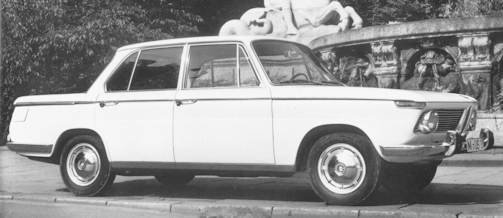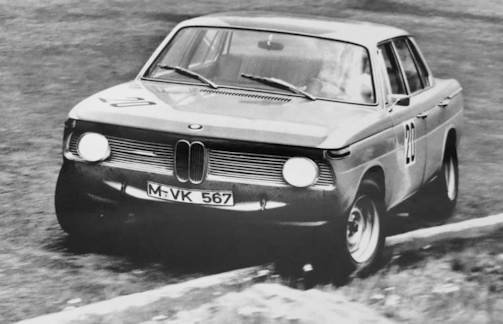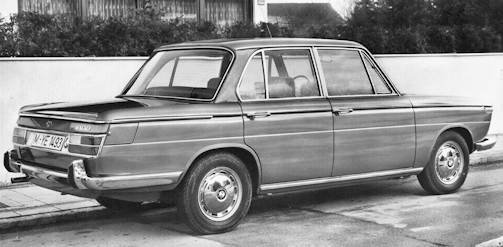BMW 1800 New Class
 | |
| Overview | |
|---|---|
| Production | 1964 to 1971 |
| Designer | Wilhelm Hofmeister Giovanni Michelotti, consultant |
| Class | Motor car |
| Body | Saloon |
| Powertrain | |
| Engine | 1,773 cc (1964–1968), 1,766 cc (1968–1971) |
| Transmission | 4-speed manual 5-speed manual on 1800 TI/SA 3-speed automatic optional on 1800/2000 |
| Dimensions | |
| Wheelbase | 100.39 in, 2,550 mm |
| Length | 177.16 in,4,500 mm |
| Width | 67.32 in, 1,710 mm |
| Height | 57.09 in, 1,450 mm |
| Dry weight | 2,293 1b, 1,040 kg |
The New Class (internal model designation 118 (1800) was a car from manufacturer BMW from the mid 1960s to the early 1970s.
History
Introduced in September 1963, the BMW 1800 was the second member of the New Class family. This model had an M10 engine with a 84 mm (3.3 in) bore and 80 mm (3.1 in) stroke, giving a displacement of 1,773 cc, a power output of 90 hp (67 kW) at 5,250 revolutions per minute, and a torque output of 96 lb·ft (130 N·m) at 3,000 revolutions per minute An 1800 TI (Turismo Internazionale) model featured components developed for the 1800 by the tuning company Alpina. The upgrades included dual Solex PHH side-draft carburetors and higher-compression pistons for 110 hp (82 kW) at 5,800 revolutions per minute and 100 lb·ft (136 N·m) at 4,000 revolutions per minute.
when the 1500 saloon appeared at Frankfurt in 1961. Five years later the same design in 1800 forms Briefly it is a spacious five-seater with 1,800 c.c. engine and particularly good roadholding. Although it feels quite big, the BMW is an easy car to drive as You sit quite high in a commanding position and can see all the corners; it weighs only 21.4 cwt. unladen, yet gives a feeling of tremendous solidity and seems particularly well insulated from the outside world with well damped road noise, little wind roar and engine noise which never rises above a distant hum.
Independent rear suspension by semi-trailing arms is a design trend which BMW were among the first to use. ,the BMW uses Macpherson struts at the front, but unlike the TI the 1800 does not have a front anti-roll bar and gives a more comfortable ride with some roll. Handling remains neutral until you corner very fast indeed for a saloon, when it is just possible to lift the inside rear wheel off the road, and the resultant momentary oversteer needs little correction.

Inside the large flat-floored boot takes 13.1 cu.ft. of luggage. The toolkit shows good engineering sense too, with more items than usual and the jack is easy to operate.sliding positions of the front seats and 33 angles of the back rest all shapes and sizes were accommodated in comfort, particularly as the leatherette upholstery with attracdve mock woven wearing surfaces helps ventilation and increases the already good sideways hold of the contoured seats.The doors are trimmed in the same material as the mixture of mock-woven and plain leather clothand pocket takes maps and flat boxes. Britax inertia-lock safety belts, Other safety points are soft sun vizors senger's with mirror), a framed mirror and a soft steering-wheel boss.
All drivers will find the controls well balanced and in the right place; the pedals are particularly smooth in operation and heel-and-toe is a very natural action. A further advantage of the driving position, in which you sit on a chair with bent knees rather than sitting low down with straight legs, is that even the smallest people will be looking easily through the deep screen and gaining a good view over the bonnet; taller people still have plenty of headroom.Behind there is plenty of room for three abreast, even for six-footers behind other
six-footers in comfort if not sprawling luxury, with those on the outside being provided with substantial roof level grab handles. The simple heating system works well within the limitations imposed by only two controls—one lever for the temperature (by air mixing) and the other to direct air up or down—together with a two-speed fan, which is noisy at the faster speed necessary for rapid heating or defrosting in town. Whether or not you like imitation wood on the facia, it is prob-
ably cheaper than the real thing to replace if scratched. The identical knobs on it are few and suffciently far apart to avoid confusion; the two-speed wiper switch is on the left and the side/head/panel light switch on the right. A left hand steering column stalk flashes or dips the headlights; a pull on the right hand one gives a squirt from the washer followed by three wipes a useful feature; it also operates the indicators and acts as a switch for parking lights once the ignition key has been removed.

A homologation special, the 1800 TI/SA, was introduced in 1964. The TI/SA's engine had dual Weber DCOE-45 carburettors and a 10.5:1 compression ratio, with 130 hp (97 kW) at 6,100 revolutions per minute and 106 lb·ft (144 N·m) at 5,250 revolutions per minute. The TI/SA also had a Getrag five-speed gearbox and thicker anti-roll bars and larger-diameter brake discs than the TI,. 200 examples of the TI/SA were built. An oversquare four cylinder engine with a five bearing crankshaft is a currently accepted formula for good reliable performance at low production costs and BMW have added to it by using a single overhead camshaft which operates inclined valves through rocker arms to give the same valve positions as with twin overhead cam- shafts, staggering the valves to induce swirl. Together with a shaped piston crown. this allows An 8.6: 1 ratio The 1800 is as quick off the mark as the TI up to 40 m.p.h. and reaches 60 m.p.h. in 12.8 seconds compared with 11.3 for the TI
Transmission the excellence of the gearbox encourages frequent use of all ratios, including first gear when you want it, since the Porsche-type synchromesh on all four gears is quite unbeatable.An automatic transmission option was introduced in 1966 and in 1967 the 1800 was generally updated along with the 2000. The updates included interior changes (a modernized dashboard design and simpler door panels) as well as styling changes to the front grilles.
In 1968 the 1,773 cc engine used in the 1800 was replaced by an engine with the 89 mm (3.5 in) bore of the 2.0 L engine and the original 71 mm (2.8 in) stroke, yielding a displacement of 1,766 cc and a stroke/bore ratio of 0.798:1 instead of the previous 1800 engine's ratio of 0.952:1.
PERFORMANCE: 1800 1,766 cu cm
- Engine capacity: 107.76 cu in, 1,766 cu cm
- Fuel consumption: 26.9 m/imp gal, 22.4 m/US gal, 10.5 1 x 100 km
- Max speed:99.4 mph, 160 km/h
- max speeds: 26.7 mph, 43 km/h in 1st gear; 50.3 mph, 81 km/h in 2nd gear; 76.4 mph, 123 km/h in 3rd gear; 99.4 mph, 160 km/h in 4th gear
- power-weight ratio: 23.8 lb/hp, 10.8 kg/hp
- carrying capacity: 882 1b, 400 kg
- acceleration: standing 1/4 mile 19.3 sec, 0—50 mph (0 —80 km/h) 9.1 sec
- speed in direct drive at 1,000 rpm: 16.7 mph, 26.8 km/h.
PERFORMANCE: 1800 Ti 1,773 cu cm
- Engine capacity: 108.19 cu in, 1,773 cu cm
- Fuel consumption: 25.7 m/imp gal, 21.4 m/US gal, 11 1 X 100 km
- Max speed: 105.6 mph, 170 km/h
- Engine capacity: 108.19 cu in, 1,773 cu cm
- Fuel consumption: 25.7 m/imp gal, 21.4 m/US gal, 11 1 X 100 km
- Max speed: 105.6 mph, 170 km/h
- max speeds: 26.1 mph, 42 km/h in 1st gear; 46.6 mph, 75 km/h in 2nd gear; 74.5 mph, 120 km/h in 3rd gear; 105.6 mph, 170 km/h in 4th gear
- power-weight ratio: 18.5 lb/hp, 8.4 kg/hp
- carrying capacity: 882 1b, 400 kg
- acceleration: standing 1/4 mile 18.4 sec, 0—50 mph (0—80 km/h)7.8 sec
- speed in direct drive at 1,000 rpm: 17 mph, 27.4 km/h.

Rating
Technical
-
BMW 1800 New Class Technical details and specifications (1964-1971)
ENGINE: 1800 1,766 cu cm
front, 4 stroke; cylinders: 4, slanted at 300, in line
bore and stroke: 3.50 x2.80 in, 89 x 71 mm
engine capacity: 107.76 cu in, 1,766 cu cm
compression ratio:8.6
max power (SAE): 102 hp at 5,800 rpm
max torque (SAE): 110 1b ft, 15.2 kg m at 3,200 rpm
max engine rpm: 6,200
specific power: 57.8 hp/l
cylinder block,cast iron
cylinder head: light alloy
crankshaft bearings: 5
valves: 2 per cylinder,overhead, slanted at 520, rockers
camshafts: 1, overhead
lubrication: gear pump,full flow filter
lubricating system capacity: 7.39 imp pt, 8.88 US pt, 4.2 1
carburation: 1 Solex 38 PDSI downdraught carburettor
fuel feed: mechanical pump
cooling system: waterENGINE: 1800 Ti 1,773 cu cm
front, 4 stroke
cylinders: 4, slanted at 300, in line
bore and stroke: 3.31 x 3.15 in, 84 x 80 mm
engine capacity: 108.19 cu In, 1,773 cu cm
compression ratio: 9.5
max power (SAE): 124 hp at 6,000 rpm
max torque (DIN): 109 1b ft, 15.1 kg m at 4,000 rpm
max number of engine rpm: 7,000
specific power: 69.9 hp/l
cylinder block: cast iron
cylinder head: light alloy
crankshaft bearings: 5
valves:2 per cylinder, overhead, Vee-slanted, rockers
camshafts: 1, side
lubrication: gear pump, full now filter
lubricating system capacity: 9.15 imp pt, 10.99 US pt,5.2 1
carburation: 2 Solex 40 PHH horizontal twin barrel carburettors
fuel feed:mechanical pump
cooling system: water
(Optional) oil cooler, filter on by-pass
(Optional) electric fuel pumpTRANSMISSION
driving wheels: rear
clutch: single dry plate
gearbox: mechanical; gears: 4 + reverse
synchromesh gears: I, II, III, IV
gearbox ratios 1800: I 3.835,II 2.053, III 1.345, IV 1, rev 4.180
gearbox ratios 1800 Ti: I 3.816,II 2.070, II 1.330, IV I, rev 4.153
gear lever: central
final drive: hypoid bevel
axle ratio: 4.110. (Optional) 4.220 4.375 4.750 5.280
(Optional) 5-speed mechanical gearbox (I 3.330, Il 2.150, III 1.565, IV 1.225, V 1, rev 3.542)
(Optional) ZF auto-matic gearbox, with 3 ratios I 2.560, II 1.520, III 1, rev 2)
(Optional) limited slip final driveCHASSIS
integral
front suspension: independent, wishbones, lower trailing links, coil springs, auxiliary rubber springs, anti-roll bar, telescopic dampers
rear suspension: independent, swinging semi-trailing arms, coil springs, air rubber springs, telescopic dampers.
(Optional) anti-roll bar on front and rear suspensions
(Optional) Competition dampersSTEERING
worm and roller
turns of steering wheel lock to lock: 3.50.BRAKES
front disc (diameter 10.55 in, 268 mm), rear drum, servo
area rubbed by linings: total 310 sq in, 1,999.50 sq cm.
Later front disc (diameter 10.71 in, 272 mm), rear drum, dual circuit, rear compensator, servo
lining area: front 29.46 sq in, 190 sq cm, rear 50.85 sq in, 328 sq cm,
total 80.31 sq in, 518 sq cm.ELECTRICAL EQUIPMENT
voltage: 12 V
battery: 44 Ah and 57 Ah
dynamo: 200/300 W alternator, 500 W
ignition distributor: BoschDIMENSIONS AND WEIGHT
wheel base: 100.39 in, 2,550 mm
front track:52 in, 1,321 mm
rear track: 54 in, 1,372 mm
overall length: 177.16 in,4,500 mm
overall width: 67.32 in, 1,710 mm
overall height: 57.09 in, 1,450 mm
ground clearance:5.90 in, 150 mm
dry weight: 2,293 1b, 1,040 kg
distribution of weight: 53% front axle,47% rear axle
turning circle (between walls): 34.4 ft, 10.5 m© Motor car History
-
BMW 1800 New Class Maintenance and Service Guide (1964-1971)
The bonnet is released by a lever under the left hand end ofthe facia and it is worth remembering that to lock the bonnet again you have to pull the lever back; it is not automatically locked as you close the lid. Engine accessibility is good and the maintenance necessary is well descnbed in the handbook. The service intervals are every 4,000 miles for a "minor service" which anyone could do quite easily, or every 8 000 miles for a "major service".4,000 miles
Engine. Every 4,000 miles change engine oil and replace filter, check water level, clean petrol pump filter, check fan belt tension, clean air silencer/filter, check carburetter idling.8,000 miles
Every 8,000 miles—oil carburetter linkage, tighten engine mounting, manifold sump and cylinder head nuts, check valve clearance. change air filter and check inlet mixer valve, check exhaust system, oil door hinges and grease locks, rub sealing rubbers lightly with glycerine. Twice a year.More Maintenance
Flush out cooling system. Suspension and steering: every 4.000 miles—no attention. Every 8,000 miles—check steering mechanism and top-up idler box. check steering play and adjust if necessary. check track rod joints and tighten nuts. tighten front suspension nuts. check spring and wishbone mountings.
Transmission: every 4.000 miles grease nipples on drive shafts and front prop. shaft. check clutch free play. Every 8.000 miles—check back axle oil level. check sliding drive shaft joint oil levels. tighten gearbox and back axle bolts. Every 16.000 miles drain rear axle. sliding drive shaft joints and gearbox. Wheels and brakes: every 4.000 miles—check brake/clutch fluid resorvoir. tighten roar wheel hubs check foot and handbrake.
Every 8.000 miles—chock brake caliper mountings disc surfaces. check front wheel bearing play, check steering. remove rear drums, clean and inspect shoes, chrck footbrake and bleed.1800 1,766 cu cm
fuel: 98 oct petrol
engine sump oil: 7.39 imp pt, 8.88 US pt, 4.2 1, SAE 10W-30, change every 1,900 miles, 3,000 km
gearbox oil:1.76 imp pt, 2.11 US pt, 1 1, SAE 80, change every 14,900 miles, 24,000 km
final drive oil: 2.29 imp pt, 2.75 US pt, 1.3 1, SAE 90, change every 14,900 miles, 24,000 km;
greasing: every 3,700 miles, 6,000 km, 2 points
cooling system capacity: 14 imp pt,16.70 US Pt. 7 1.
tappet clearances: inlet 0.006-0.008 in, 0.15-0.20 mm, exhaust 0.006-0.008 in, 0.15-0.20 mm
valve timing: inlet opens 4° before tdc and closes 52° after bdc, exhaust opens 52° before bdc and closes 4° after tdc
normal tyre pressure: front 24 psi, 1.7 atm, rear 24 psi, 1.7 atm.
(Optional)165 x 14 tyres1800 Ti 1,773 cu cm
fuel: 95-100 oct petrol
engine sump oil: 8.80 imp pt, 10.57 US pt, 5 1, SAE 10W-30, change every 1,900 miles, 3,000 km
gearbox oil: 2.11 imp pt, 2.54 US pt, 1.2 1, SAE 80, change every 15,000 miles, 24,100 km;
final drive oil: 1.40 imp pt, 1.69 US pt, 0.81, SAE 90, change every 15,000 miles, 24,100 km
cooling system capacity: 12.32 imp pt, 14.80 US pt, 7 1.
greasing: every 3,700 miles, 6,000 km, 3 points
tappet clearances: inlet 0.008 in, 0.20 mm, exhaust 0.008 in, 0.20 mm
valve timing: inlet opens 4° before tdc and closes 52° after bdc, exhaust opens 52° before bdc and closes 4° after tdc
tyre pressure (medium load): front 26 psi, 1.8 atm, rear 26 psi, 1.8 atm.
tyres: 6.00 x 14
fuel tank capacity: 11.7 imp gal, 14 US gal, 53 1.© Motor car History




